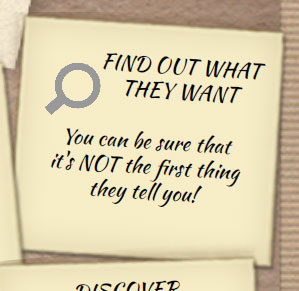
As we said a couple of days ago, what prospective clients want to hear about is how you can help them solve their problems.
Feldenkrais® Practitioners typically ask their first-time clients “Why are you here?” or “How can I help you?” or “What bothers you?”
There’s nothing wrong with these questions. Unfortunately, most of the time, the person sitting in front of you for a first Feldenkrais session will say something like, “I have back pain.” Or “I’ve had 3 car accidents, and I can’t sleep because my neck hurts so much.” Or maybe they say “I just found out I have MS/Parkinson’s/ALS” or “My baby has global brain damage.”
Probably the most obvious thing to the person sitting on your table — and maybe the most obvious thing to you, too — is that what they want is NOT to have what they DO have. They just want it to go away and then things will be like they used to be… “you know — normal.”
The problem is that the obvious answer — the easy answer — is not the whole story. Usually, it’s not even half of it. If you habitually stop here, you don’t know how to help your clients really commit to getting what they want. And if they don’t commit, you can’t help them because after the first session, they aren’t going to be lying on your floor for a class or on your table for another go.
You need to know not only what they want but why they want it and what it means to them. In order to ask the questions that elicit answers at that level, you have to come from your own heart. You need to be really present to the other person — without caring whether or not you get a client out of it.
You can’t fake that, and this one more reason why becoming more of who you are is essential to getting more clients.
~~~~~
“If you come across something obviously new to you, in its form at least, please stop for a moment and look inward. Working out new alternatives assists us to grow stronger and wiser.” — Moshe Feldenkrais, in The Elusive Obvious

